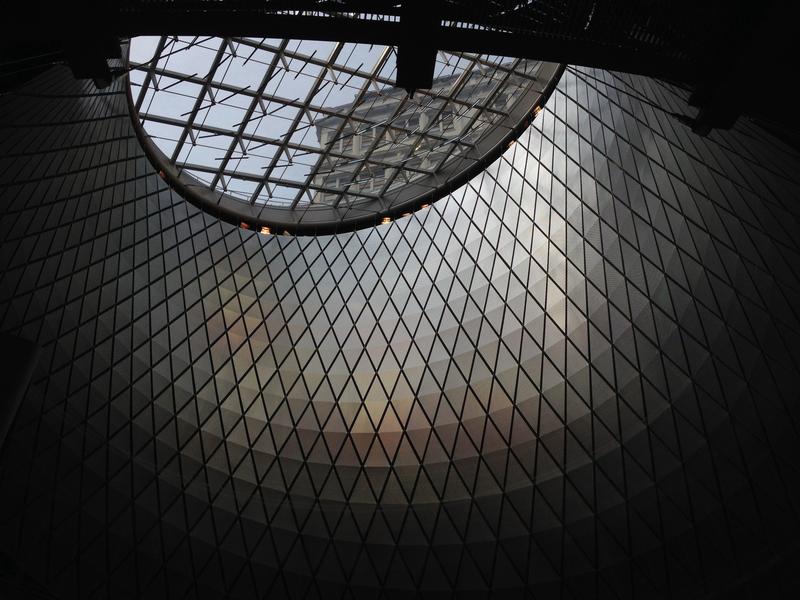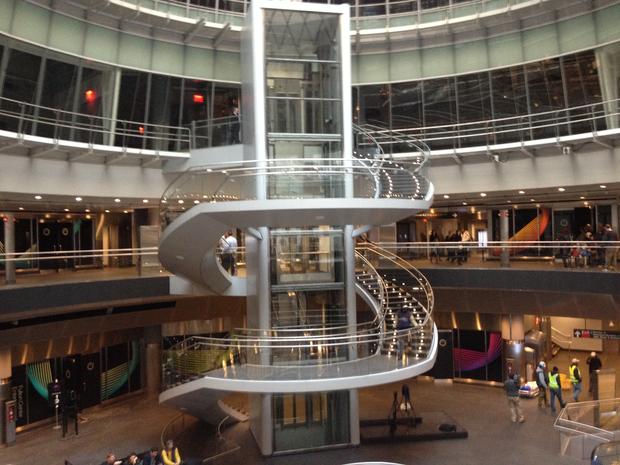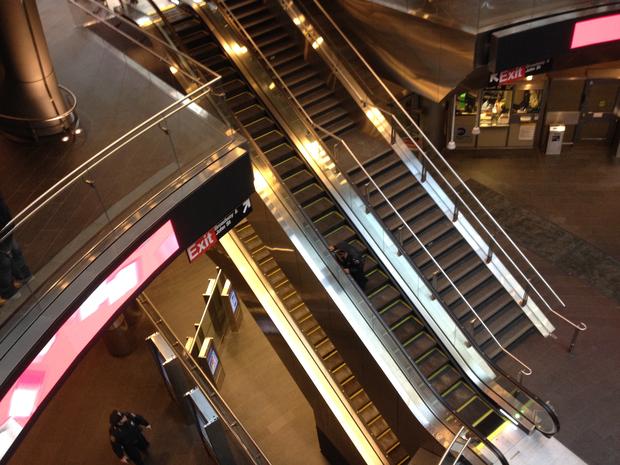 Transportation Nation
Transportation Nation
MTA Opens 'Magical' Fulton Center Transit Hub

Officials from the Metropolitan Transportation Authority joined local leaders Sunday to cut the ribbon for the new Fulton Center transit hub in lower Manhattan, a gleaming glass and steel building on the south east corner of Fulton Street and Broadway.
The $1.4 billion Fulton Center was designed to provide commuters easier access to nine New York City subway lines and to create a new public space and retail complex that officials hope will rival other landmark destinations across the city.
“The lions at the New York Public Library, the clock in the middle of Grand Central terminal, and now, this jaw-dropping oculus,” said MTA Chairman Tom Prendergast.
The glass and steel building, designed by Arup and Grimshaw Architects, on the south east corner of Fulton Street and Broadway is centered around that soaring oculus and a spiraled dome, which has been lined with 952 diamond shaped reflective panels, called the Sky Reflector Net, that hang above and draw sunlight into the building two flights below street level. That piece is the product of a collaboration between James Carpenter Design Associates, Grimshaw Architects, and Arup commissioned by the MTA.
Dr. Michael Horodniceanu, president of MTA Capital Construction, said the new transit hub embodies the vibrancy of a 24/7 downtown Manhattan community that has rebounded and grown by 40,000 people since the devastating September 11th attacks in 2001. He also hailed the building’s unique design.
“We needed something magical,” Dr. Horodniceanu said.
The Fulton Center was paid for primarily with federal funds including $847 million out of $20 billion granted to lower Manhattan after the September 11th attacks. There’s also $423 million in stimulus funds from the American Recovery and Reinvestment Act and $130 million from the MTA.
To keep projects like this moving forward, the Federal Transit Administration’s Acting Administrator Therese McMillian said her agency was asking the new Congress to support the Obama administration’s $302 billion Grow America Act, which federal officials originally unveiled last April.
The new Fulton Center was full of bells and whistles including all digital signage, climate control and WiFi. It also includes a new 350-foot-long pedestrian tunnel constructed under Dey Street, which currently links to the R train.
MTA officials say the center will accommodate up to 300,000 daily riders.
Of the nearly 66,000-square-feet of retail and office space that is being managed and operated by the Westfield Group, none has been leased yet.
The MTA also still faces a massive budget gap in its proposed 2015-2019 capital budget plan. It was a topic that none of the ceremony’s 11 speakers was willing to broach, except for Congressman Jerry Naddler of Manhattan.
“We’re not talking about that today, but I’ll mention it. There’s a $15 billion shortfall,” said Nadler. “We must fill that and not by reducing [the MTA’s] ambition.”
Nadler went on to recall being a member of the New York State Assembly along with now U.S. Senator Charles Schumer, also at the ceremony, when then MTA Chairman Richard Ravitch pointed out another $15 billion budget shortfall of needed capital funds from 1980-1990.
“We filled them. We did what we had to do to restore the subway system, the mass transit system to a state of good repair and a state where people wanted to use it. That must continue,” said Nadler.
One of the key people who will determine how much money the state kicks in to close that gap, Assembly Speaker Sheldon Silver, was also at the ceremony. Speaking to WNYC after the ceremony, Silver gave little indication about how lawmakers planned to close the gap.
“That $15 billion is in a five-year capital plan. It’s not a one-year capital plan,” said Silver adding, “hopefully with a better economy some of those funding sources like real estate transfer taxes will bring in more money for the MTA capital plan.”
Asked whether he agreed with Governor Andrew Cuomo’s assessment last month that the MTA’s capital plan was “bloated,” Silver gave a mixed response.
“I haven’t examined the MTA’s capital budget yet to make that determination. But that would be part of it, clearly. There may be a little excess but the reality is a lot of it has to be funded.”


